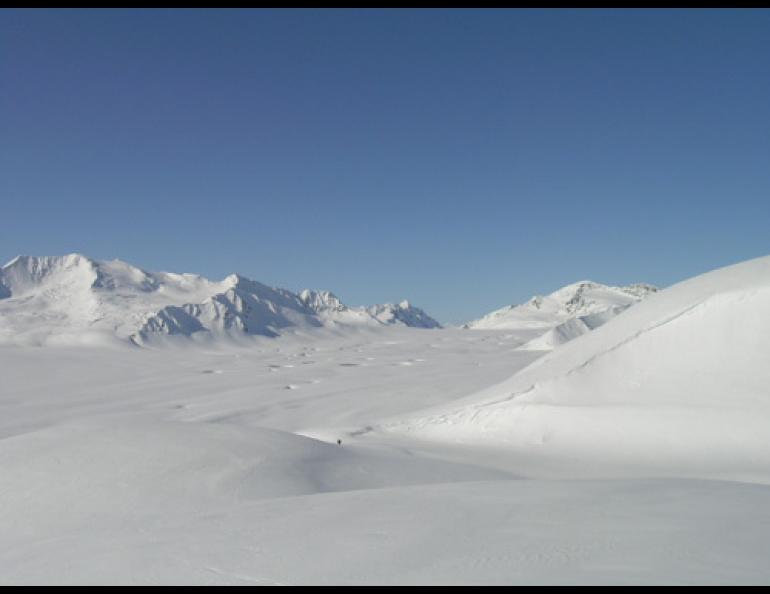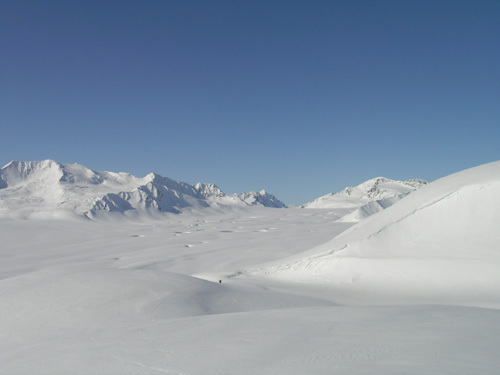
Ice dies, fire survives in Interior Alaska
Summer 2004 left its mark on millions of acres of Alaska now scorched by fire and also in a place where few people will notice it—the shrinking surface of an Alaska Range glacier.
Martin Truffer just returned from Black Rapids Glacier and found that it melted more in the summer of 2004 at five measurement points than it has since people began doing measurements on the glacier in 1973.
“Not only was 2003-04 a low snow year in the Alaska Range, but it was followed by a record-breaking summer in Interior Alaska,” Truffer, a glaciologist at UAF’s Geophysical Institute, wrote in an email to his colleagues. “The result was the most negative mass balance measured in the 32-year long series.”
Truffer spent four days in late April 2005 on the glacier with Sandy Zirnheld and Jason Amundson of the Geophysical Institute. They traveled up and down the glacier and measured the ice thickness at five spots, beginning at a measurement post frozen into the glacier about 5 miles from its source high in the central Alaska Range. That spot, about 6,300 feet above sea level, usually stays cold enough that snow keeps piling up there and morphing into glacial ice. The summer of 2004—when Nome, Fairbanks, Anchorage, King Salmon, Valdez, and Juneau all experienced the warmest summer on record—was hot enough to stunt the growth of Black Rapids up high.
“The glacier has only lost mass at that altitude twice in the last 30 years,” Truffer said. “All the snow on top of the ice melted at that elevation last year, which is unusual.”
Another unusual event of spring 2005 was the fire that came back to life northeast of Dot Lake after surviving a long Alaska winter.
Firefighters call fires that overwinter “holdover fires,” said Chris Maisch, the regional forester at the Alaska Division of Forestry office in Fairbanks. In early May 2005, a dozen firefighters were out mopping up a two-acre fire in the Billy Creek area that was the offspring of a 460,000-acre fire last summer. Somehow, the fire survived snowfall and months of below freezing temperatures to spring back to life at the urging of a stiff April wind.
“Holdover fires aren’t a normal occurrence,” Maisch said. “In the six years I’ve been in this job, this is the first time I’ve seen it.”
The Billy Creek fire might have smoldered in a squirrel midden or buried tree all winter, Maisch said. Red squirrels cache spruce cones in stockpiles called middens that spill over the floors of spruce forests. Generations of squirrels use the same middens, built of spruce cones and seeds, which are excellent fuel for a smoldering fire.
“It’s an oxygen-starved environment where there’s enough to maintain combustion but not enough to let it burn out,” Maisch said. “It doesn’t need a lot of oxygen to stay alive.” He compared a fire in a midden or a buried tree to a house fire that smolders until someone opens a door and the fire explodes to life.
Because a fire needs oxygen, fuel and heat, the insulation of a midden or other buried organic material by snowfall might also keep the fire alive by providing a warmer environment to wait out the winter.
“Just like all these insects and mammals hibernate by staying close to the ground, the fire sort of does the same thing,” Maisch said. “It’s not maintaining combustion at 40 below, but at just below freezing.”





